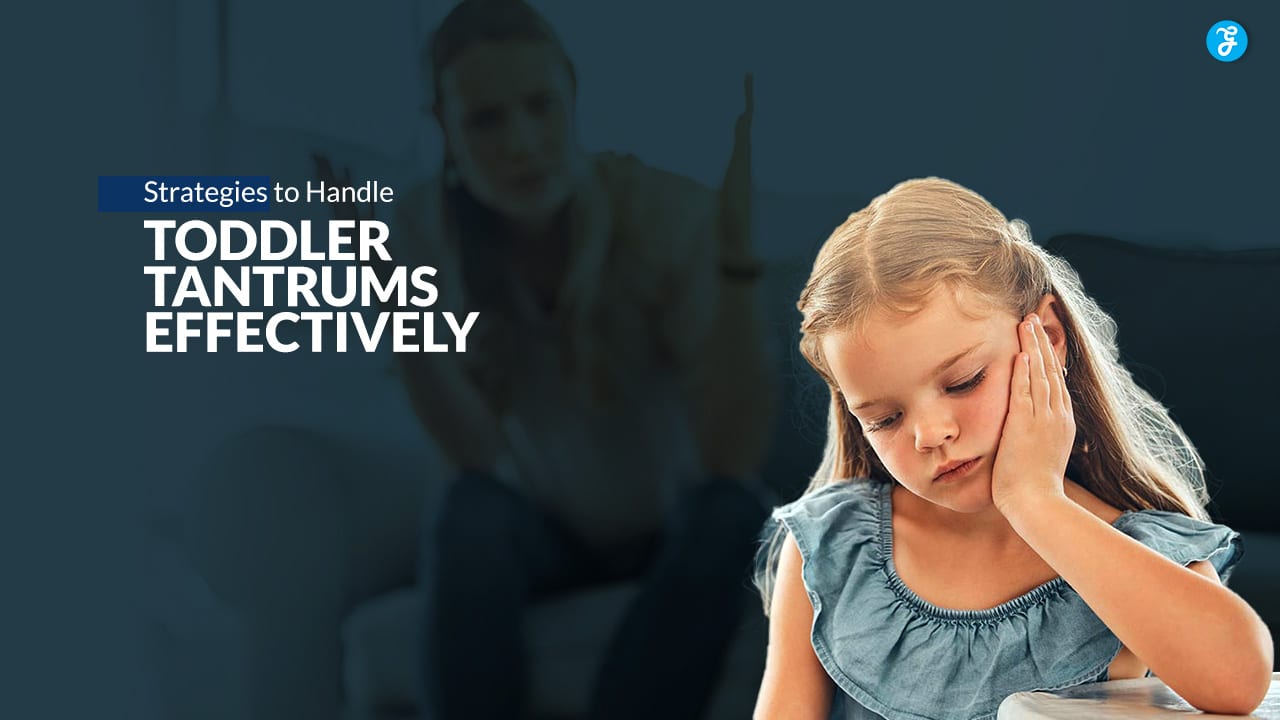Toddler tantrums can be overwhelming, both for the child experiencing them and the adults trying to manage the situation.
These emotional outbursts are a normal part of child development, as toddlers are still learning to regulate their emotions, express their feelings, and navigate the world around them.
Tantrums typically occur when toddlers feel frustrated, tired, hungry, or unable to communicate their needs effectively.
For parents, handling these meltdowns calmly and consistently is key to teaching children emotional regulation skills.
In this detailed guide, we’ll explore 15 effective strategies that can help you manage toddler tantrums in a positive and nurturing way, fostering both understanding and emotional growth.
1. Stay Calm and Composed
Toddlers are highly perceptive and can easily pick up on the emotions of the adults around them.
If you react with frustration, anger, or anxiety during a tantrum, your child is likely to escalate their emotions.
Maintaining a calm demeanor sets a positive example for your toddler and helps de-escalate the situation.
- What to Do:
When your child starts throwing a tantrum, take a moment to pause and regulate your own emotions.
Take deep breaths, count to ten, or remind yourself that tantrums are a normal developmental phase.
Approach your child with a calm, soothing voice and body language.
- Why It Works:
Toddlers often mirror the behavior of the adults they trust.
By staying calm, you show them that tantrums don’t need to lead to chaos, and it helps them feel safer in expressing their emotions.
Pro Tip
Try to develop a calming routine for yourself, such as deep breathing or silently counting, before you respond to your toddler.
This helps prevent you from reacting impulsively and maintains a calm atmosphere during tantrums.
2. Acknowledge and Validate Their Feelings
One of the reasons toddlers have tantrums is because they don’t yet have the language skills to express their complex emotions.
Acknowledging and validating their feelings lets them know that you understand their frustration, even if you don’t give in to their demands.
- What to Do:
Get down to their eye level and say things like, “I see you’re really upset because we had to stop playing,” or “I know you wanted that toy, and it’s frustrating when you can’t have it right now.”
- Why It Works:
Validation helps toddlers feel seen and heard, which can diffuse the intensity of their emotions.
It teaches them that all feelings are valid, even if certain behaviors (like hitting or screaming) are not.
Pro Tip
Use simple, direct language when acknowledging their feelings.
Toddlers need to hear clear and concise statements that help them identify their emotions, which aids in emotional development.
3. Set Clear and Consistent Boundaries
Toddlers often test boundaries to understand how the world works.
Clear and consistent rules help them feel secure, as they know what is expected of them.
Setting boundaries during tantrums teaches your child that certain behaviors are unacceptable, even when they are upset.
- What to Do:
When a tantrum begins, gently but firmly remind your toddler of the established rules.
For example, if your child hits you out of frustration, calmly say, “We don’t hit. Let’s use gentle hands.”
- Why It Works:
Consistent boundaries help toddlers understand that tantrums don’t change the rules.
It also provides them with structure, which is comforting for young children who are still learning about self-control.
Pro Tip
Make your boundaries clear and age-appropriate.
Toddlers may struggle with too many rules, so keep your expectations simple and consistent across different situations.
4. Use Distraction and Redirection
Toddlers have short attention spans, and their emotions can change quickly.
Distraction and redirection are effective tools for preventing a tantrum from escalating.
Instead of focusing on what’s causing their frustration, you can offer an alternative activity that shifts their focus and calms them down.
- What to Do:
If your child is upset because they can’t have something (like a toy at the store), redirect their attention by offering a new activity.
You could say, “Let’s go find something fun in the car,” or offer them a different toy or game.
- Why It Works:
Shifting focus allows toddlers to move away from their source of frustration and engage with something positive.
This technique works especially well when you sense a tantrum is about to start.
Pro Tip
Keep a few favorite small toys or snacks in your bag when going out in public to use as distractions in case of tantrums.
They can serve as tools to divert your toddler’s attention in a positive way.
5. Offer Controlled Choices
Many tantrums occur because toddlers feel they have no control over their environment.
Offering choices within boundaries empowers them to make decisions and gives them a sense of autonomy, which can help prevent power struggles.
- What to Do:
Instead of saying, “You have to put on your shoes,” offer two options: “Do you want to wear your red shoes or your blue shoes?”
This gives them the opportunity to feel in control while still following your guidelines.
- Why It Works:
Giving toddlers choices reduces feelings of helplessness and frustration.
They are more likely to comply when they feel they have some say in what’s happening.
Pro Tip
Limit choices to two or three options.
Too many choices can overwhelm a toddler and lead to further frustration.
Keep the options simple and directly related to the task at hand.
6. Stick to Routines
Toddlers thrive on routine because it provides them with a sense of predictability and security.
When routines are disrupted, they can feel unsettled, which may trigger tantrums.
Maintaining consistent daily routines for meals, naps, and playtime can help reduce tantrum triggers.
- What to Do:
Keep your child’s schedule consistent, especially for important daily activities like naps, meal times, and bedtime.
If a change in routine is necessary (e.g., visiting relatives or running errands), prepare your toddler by explaining the change in advance.
- Why It Works:
Predictable routines help toddlers understand what to expect, reducing anxiety and frustration.
When they know what’s coming, they feel more in control and less likely to have emotional outbursts.
Pro Tip
If you need to change the routine, give your child plenty of warnings ahead of time.
For example, “After lunch, we’re going to Grandma’s house instead of taking a nap,” will help them adjust mentally to the change.
7. Use Positive Reinforcement
Positive reinforcement encourages good behavior by praising and rewarding your child when they manage their emotions well.
By focusing on the positive moments, you reinforce that behaving appropriately leads to positive outcomes.
- What to Do:
When your toddler calms down or behaves well, praise them immediately.
For example, “You did a great job using your words instead of yelling!” or “I’m so proud of how you shared your toys.”
- Why It Works:
Positive reinforcement motivates children to repeat good behaviors because they learn that these actions are noticed and appreciated.
This reduces the likelihood of future tantrums and promotes emotional growth.
Pro Tip
Be specific in your praise. Instead of saying, “Good job,” try saying, “I love how you stayed calm when you couldn’t have the toy.”
This helps toddlers understand exactly what behavior you’re praising.
8. Teach Problem-Solving Skills
Tantrums often arise because toddlers haven’t developed the skills to solve their problems on their own.
By teaching simple problem-solving techniques, you empower them to manage frustration in a healthier, more effective way.
- What to Do:
When your child starts to get frustrated, help them work through the problem.
For example, if they’re upset that a toy isn’t working, ask, “What can we do to fix this? Can we ask for help or try again?”
- Why It Works:
Problem-solving teaches toddlers that there are alternative ways to handle frustration besides throwing a tantrum.
This skill also fosters independence and resilience.
Pro Tip
Use simple language and visual cues to explain problem-solving techniques.
For example, you can demonstrate asking for help or show them how to calm down before trying again.
9. Practice Deep Breathing Together
Toddlers don’t always know how to calm their bodies during a tantrum.
Teaching them deep breathing techniques can help them regain control of their emotions by focusing on their breath and relaxing their bodies.
- What to Do:
During or after a tantrum, model deep breathing by saying, “Let’s take a deep breath together.” Breathe in through your nose for a count of four, and then slowly exhale through your mouth.
You can make it fun by telling them to imagine blowing out birthday candles.
- Why It Works:
Deep breathing reduces the physiological effects of stress and helps toddlers calm down faster.
It also gives them a tool they can use independently when they feel overwhelmed.
Pro Tip
Make deep breathing into a game by using fun imagery like blowing bubbles, smelling flowers, or blowing out candles.
This turns the calming exercise into something your child enjoys doing.
10. Avoid Giving In to Tantrum Demands
While it can be tempting to give in to a tantrum to make it stop, this reinforces the behavior. If toddlers
learn that tantrums get them what they want, they are likely to continue using this method to meet their needs.
- What to Do:
Stay firm in your decision, even if your child is screaming or crying.
Calmly say, “I understand you’re upset, but we can’t have candy before dinner.”
Offer a distraction or alternative, but don’t give in to the tantrum’s demands.
- Why It Works:
Consistency teaches toddlers that tantrums are not an effective way to get what they want.
Over time, they’ll learn that calm communication and patience are more successful approaches.
Pro Tip
When you say “no,” offer an alternative to show your toddler that while they may not get what they want, there’s still a positive solution.
For example, “We can’t have candy now, but we can have a snack after dinner.”
11. Address Basic Needs
Basic needs like hunger, exhaustion, or overstimulation are often the cause of tantrums.
Ensuring that your toddler’s needs are met before they become overwhelming can prevent tantrums from occurring.
- What to Do:
If your child is starting to get fussy, check if they might be tired, hungry, or overstimulated.
Keep snacks, water, and comfort items like a favorite toy or blanket on hand when you’re out and about.
- Why It Works:
Meeting basic needs before frustration sets in can prevent meltdowns.
A tired or hungry child is more likely to become emotionally dysregulated, so addressing these needs helps keep tantrums at bay.
Pro Tip
Create a schedule for meals, naps, and quiet time to ensure your toddler’s basic needs are consistently met.
Be mindful of how overstimulation (like noisy, crowded places) might impact their behavior.
12. Provide Warnings Before Transitions
Transitions, such as leaving the park or stopping playtime to eat, are common triggers for toddler tantrums.
Providing a warning gives toddlers time to mentally prepare for the upcoming change, reducing the likelihood of an emotional outburst.
- What to Do:
Give your child a heads-up before moving on to a new activity. For example, “In five minutes, we’ll be leaving the playground to go home,” or “After one more story, it’s time for bed.”
- Why It Works:
Giving toddlers time to adjust to changes reduces the shock of suddenly stopping a fun activity.
It helps them transition more smoothly from one part of their routine to the next.
Pro Tip
Use a timer to provide a visual or auditory cue for your toddler.
For instance, set a five-minute timer before the transition to help your child see and understand how much time they have left.
13. Stay Present but Avoid Excessive Attention
Tantrums can escalate if toddlers sense that they are getting too much attention for their behavior.
However, completely ignoring them can also increase their frustration. Striking a balance between being present and not reinforcing the tantrum is essential.
- What to Do:
Stay close by while your child is having a tantrum to ensure they’re safe, but avoid overly engaging with them.
Let them know you’re there when they’re ready to calm down, and offer comfort when they begin to settle.
- Why It Works:
Being present provides reassurance without encouraging more attention-seeking behavior.
Your child learns that tantrums won’t result in extra attention but that you are there to support them when they are calm.
Pro Tip
If the tantrum occurs in public, calmly and quietly move your child to a more private space, such as your car or a quiet corner.
This allows them to calm down without feeling embarrassed or overstimulated by their environment.
14. Encourage Verbal Communication
Toddlers often experience tantrums because they lack the language skills to communicate their feelings and needs.
Encouraging them to use words helps reduce frustration and promotes better emotional expression.
- What to Do:
Teach your child simple phrases like “I’m angry,” “I need help,” or “I’m tired.”
When they start to become upset, prompt them to use these phrases instead of crying or yelling. For example, “Can you tell me what’s wrong?”
- Why It Works:
Teaching toddlers to communicate their needs verbally empowers them to express themselves more effectively.
As their language skills improve, they’ll feel less frustrated and resort to fewer tantrums.
Pro Tip
Model effective communication by verbalizing your own feelings.
For example, “I’m feeling frustrated because I can’t find my keys, but I’m going to take a deep breath and try again.”
This teaches your toddler to use words to express their emotions.
15. Be Patient and Empathetic
Tantrums are a natural part of your toddler’s emotional development. During these outbursts, they are learning how to manage big emotions, which can be overwhelming for them.
Patience and empathy go a long way in helping your child feel supported during these difficult moments.
- What to Do:
Show empathy by acknowledging your child’s emotions and offering comfort when needed.
Say things like, “I know it’s hard when you’re upset,” or “It’s okay to feel sad.”
Practice patience by reminding yourself that tantrums are a phase, and with the right support, your child will learn better emotional regulation over time.
- Why It Works:
Empathy builds trust and emotional security. When children feel understood, they are more likely to calm down and feel safe in expressing their emotions.
Pro Tip
Take care of your own emotional needs as well.
Tantrums can be exhausting for parents, so it’s important to take breaks, practice self-care, and seek support when needed.
Final Thoughts
Tantrums are a normal part of toddlerhood, and with the right strategies,
you can navigate these emotional outbursts with patience, empathy, and consistency.
By staying calm, setting boundaries, and teaching your child emotional regulation skills, you help them develop the tools they need to manage frustration and express their feelings in a healthy way.
Remember, each child is unique, so not every strategy will work every time. It’s important to stay flexible and adapt your approach as your child grows and learns.
With time, you’ll find that handling tantrums becomes easier, and your child will gain the emotional skills they need to navigate their world with confidence.







































